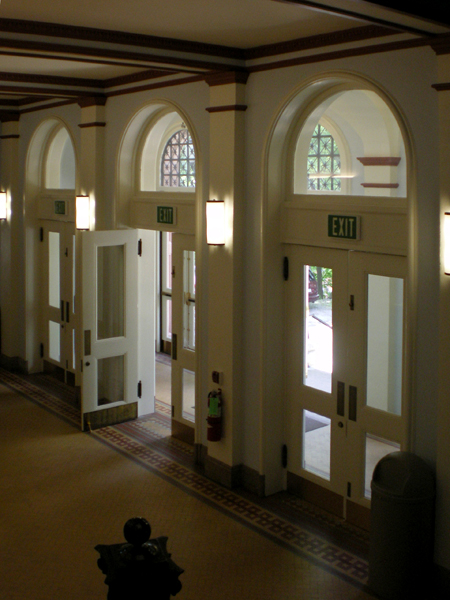The Andrew Carnegie Free Library & Music Hall, or simply the Carnegie Carnegie, has served Carnegie and its surrounding communities as the “beacon on the hill” since 1901.
In the 1890s, the leaders of what were then Chartiers and Mansfield, on either side of Chartiers Creek, approached Andrew Carnegie with the proposition that they merge to become one town. Carnegie Borough incorporated in 1894, and the Carnegie Carnegie was built as Andrew Carnegie’s legacy gift to the new town that took his name.
Though he funded 2,500 libraries around the world, the industrialist-turned-philanthropist endowed only five libraries. We are proudly one of them. The four others include Braddock, Homestead, Duquesne (demolished), and the very first Carnegie Library in the world in Dunfermline, Scotland, Andrew Carnegie’s birthplace.
In 1981, we were listed on the National Register of Historic Places.
Unfortunately, endowment was not a good model. In the 1980s, we had $136 in our checking account after payroll. Decades of poverty and egregious water damage threatened not only our 35,000 sq. ft building, but our programs, our capacity, and, ultimately, our ability to continue serving our community.
That changed in late 2003. The Chartiers Valley Partnership launched a capital campaign to restore our building with a $500,000 challenge grant. The Challenge: the community had to contribute a dollar-for-dollar match to secure the grant. It had to do so without foundation, government, or corporate support. And it had just 10 months to reach its goal.
How the community reached that goal has become the stuff of legend. In a burst of generosity, the community donated the remaining $60,000 needed between the September 17, 2004 flood that ravaged Carnegie and the end of the month deadline.
Today, more than $15 million later, our building is structurally sound, weatherproof, partially air conditioned, and accessible. Interior restoration includes our Music Hall lobby and upgraded seating. The meticulous restoration of the Captain Thomas Espy Post of the Grand Army of the Republic in 2010 garnered national and international attention. One hundred photographs of the 16th President complement the Post in the adjacent Lincoln Gallery.
Our basement gym became the Studio in 2011. Upgrades in 2022 have positioned the Studio as a venue for art shows, symposia, job fairs, trainings, poetry readings, and intimate musical performances. The long-awaited restoration of the Library in 2015 has staff asserting, “Close your eyes and picture a library. Chances are you will picture us.”
Library Park opened in April 2022. Initiated in 2017, its development was interrupted by a mudslide in 2018 that stalled the momentum of the project, followed by the pandemic. The park converts the ACFL&MH’s steep grounds from a barrier into inviting green space for the first time connecting the Library & Music Hall to Carnegie’s Main Street. Library Park draws people “up and in” to ACFL&MH services, programs, and performances, and helps position Carnegie as one of the region’s more attractive destination communities.
In 2022, we completed the Mezzanine, a multi-use space located off of the Studio, that is used for meetings, cooking classes, trainings, and more. Now, we are working to raise the remaining funds needed to finish the Music Hall restoration, which will maximize the hall’s potential as one of our region’s finest historic venues. Planned improvements include replacing knob-and-tube wiring; installing new house lighting; repairing plaster and repainting; replacing the 120-year-old stage floor; adding a sprinkler system and other safety upgrades; and adding air conditioning.
Upgrades to programming have kept pace with facility improvements. We are very much a library and so much more! Services and programming are creative, eclectic, and ever-evolving to meet evolving community needs.
One of our most impactful moments came in late 2016. Recognizing our value and responding to an outpouring of community support, Carnegie Borough signed a 20-year contract with us to ensure a stable and generous funding source for the first time in its history.
The Carnegie Carnegie is once again beautiful, vibrant, and beloved. Our remarkable journey continues…
Building & Architecture
The Carnegie Carnegie was designed by Struthers and Hannah in 1899. The two-story Italianate facade has a rusticated stone base, capped with a continuous bracketed cornice and hip roof. The facade is composed of russet colored brick with terracotta trim.
The Music Hall is dominated by a projecting central entrance bay topped with a slightly smaller pediment. Stairs lead to three double entrance doors with elongated arched transoms. An open second story porch sits above the entranceway. Three windows are separated by paired Corinthian columns with brick shafts. Elegant arch-topped windows have circles and patterns that combine with the decorative terracotta to echo the building’s Palladian antecedents.






